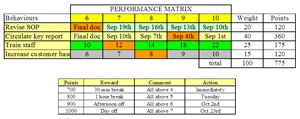Appraisals part 2
The performance matrix
The performance matrix is a simple table of desired behaviours against a measurement of progress.
Management is about control of activities and monitoring performance.
This can take a lot of time, so, it makes sense if the individual can so it for themselves.
By creating a simple table matrix (see the above diagram) it is possible for individuals to keep daily track of their own performance.
The above diagram is a simplified version of the possible finished article.
Here we have identified 4 behaviours we are trying to encourage, usually either by increased frequency (do the behaviour again) or by rate (do it faster).
The point scoring here goes from 6 to 10 (for simplicity) and misses out other values from 1 to 5.
Taking the first behaviour as an example.
If the SOP (Standard Operating Procedure) is completed and circulated by Sep 10th the person will get 10 points if by Sep 19th only 6 points.
The person can get 9 points for training 18 staff or 7 points for gaining an extra 7 customers.
The actual performance at the end of the month is given by the orange boxes.
However, all the tasks will not have equal weighting in terms of importance or urgency (these are defined more rigorously in ‘The Complete Time Management package’).
Thus, the manager can ‘weight’ individual tasks according to the priorities, which if given as a percentage, as here, must add up to 100%.
By multiplying the weight x points score we get the total score for that task.
The total points can then be added to give, in this case, 775 points.
A reward system can then be implemented which is based upon actual individual performance.
An example of a reward structure is shown in the diagram above but could be anything agreeable to the individual and sanctioned by senior managers.
Space can be made for simple comments and action taken etc.
This system is open to easy modification should priorities change.
It may take a little work to set up but should more than pay for itself in terms of improved performance; which is good for the individual and the organisation.
All jobs can be measured in this manner.
There will be no competition with others; you will be judged purely on your own performance.
When an individual tracks their own performance in this manner it acts as its own positive reinforcement.
Motivation increases.
The reward table is only limited by your imagination in the way you utilise the results data.
You could link constant high results with annual increases or bonuses, for example.
Of course in reality many managers may not possess the flexibility they would desire to implement their preferred system.
Issues
Appraisals are far from easy to carry out.
They can be very subjective when people are rated and graded against others.
It is easy to see peoples’ performances as an individual when in fact it may have arisen under the influence of a team or other individuals.
Done well they can improve performance; done badly decreased motivation will result.



